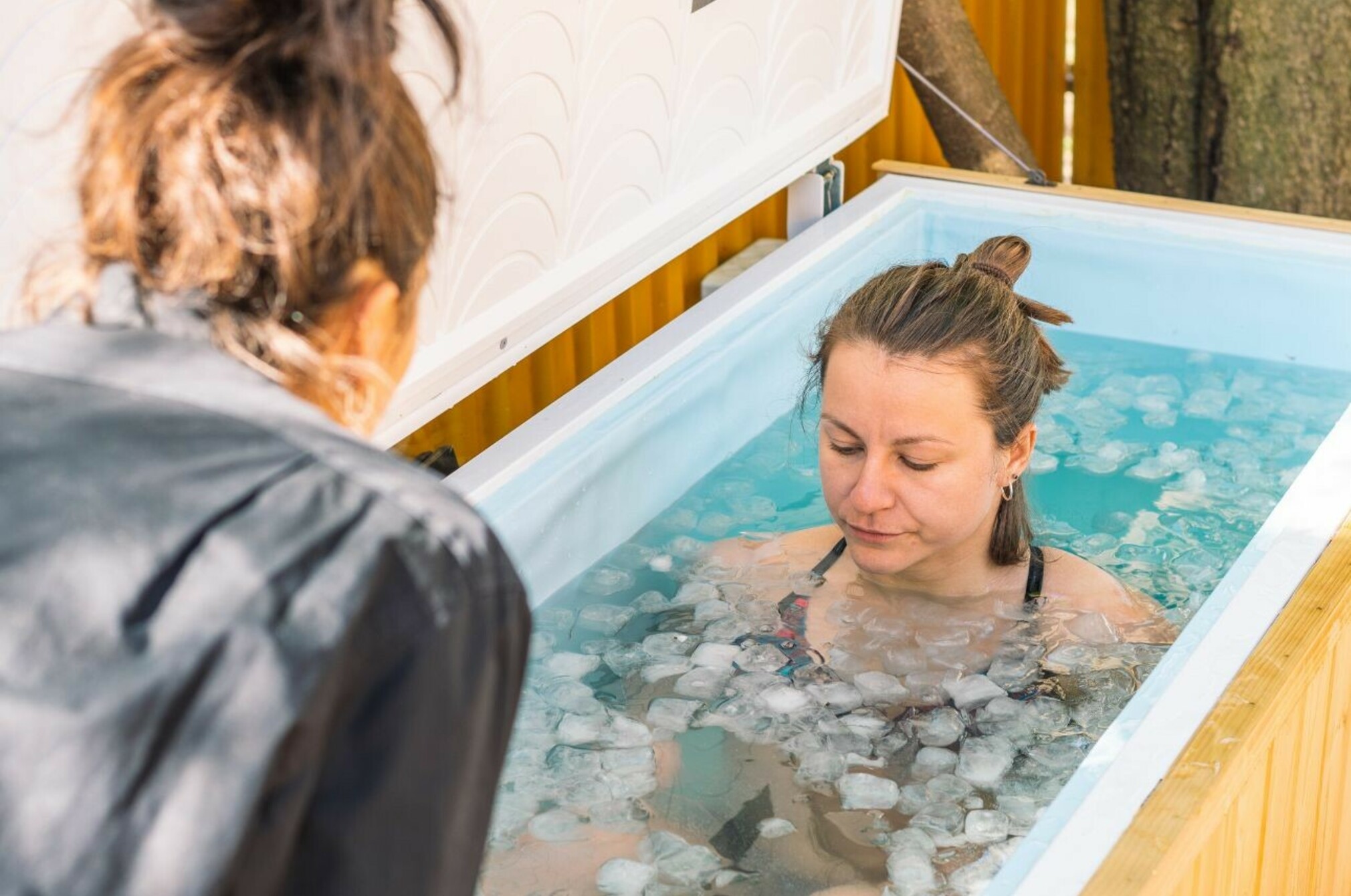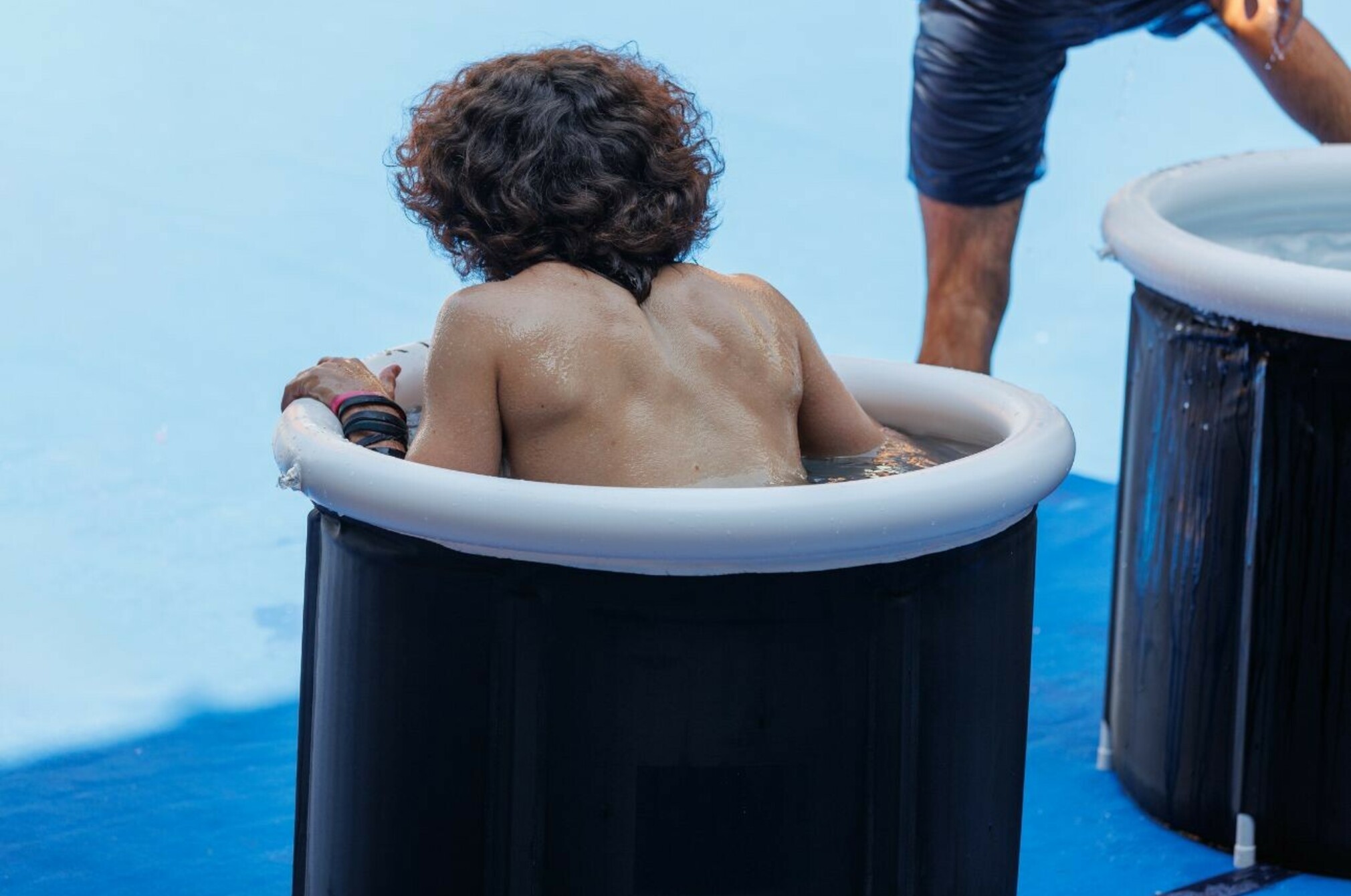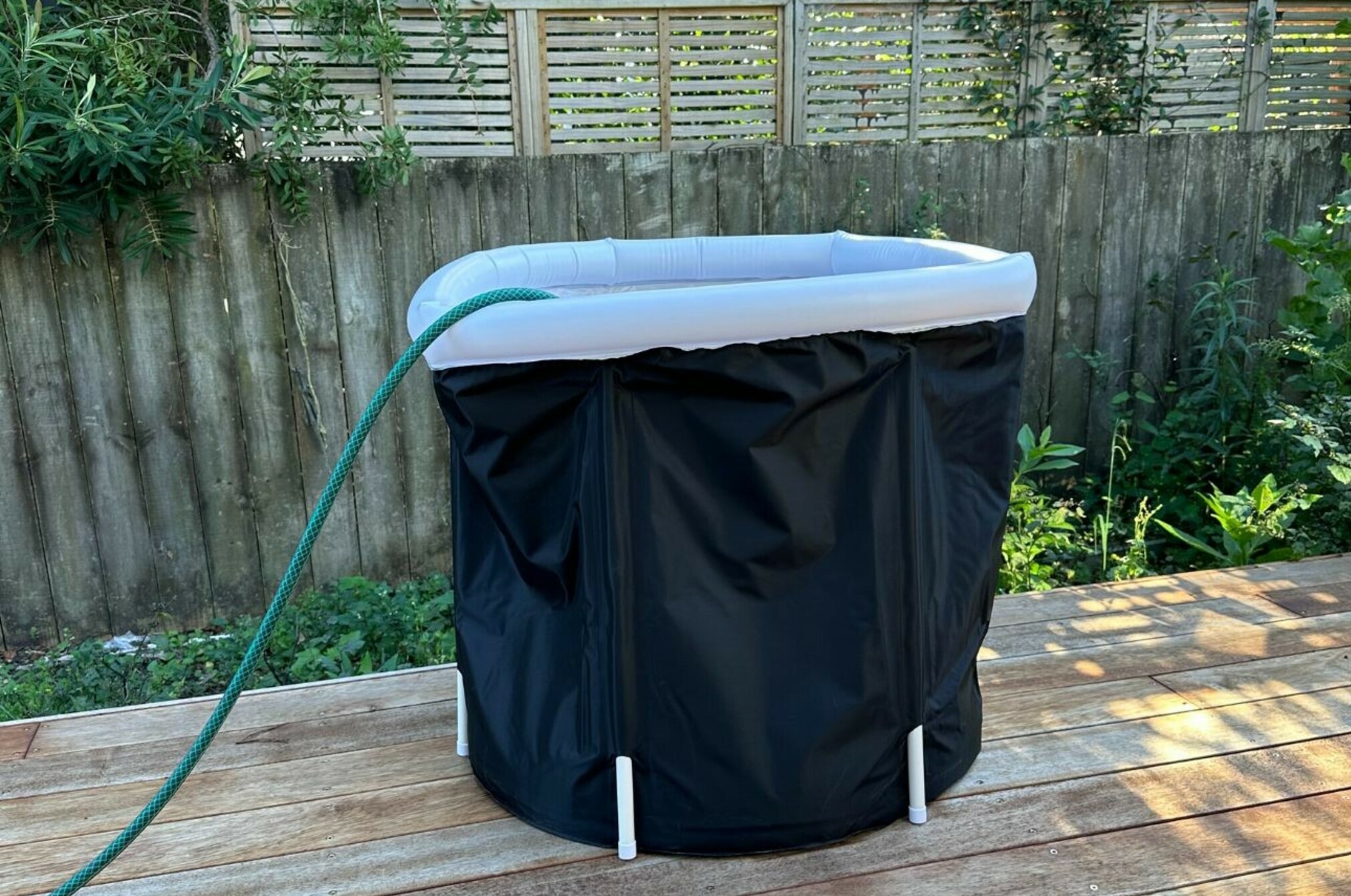Ice baths: Are cold plunges healthy, just hype or potentially harmful?

Can bathing regularly in icy water really improve your life? Or is the hyped wellness trend a waste of time? Consumer takes a chilly dip and discovers while some enjoy and promote potential health benefits, others say they can be dangerous.
On April 24, it was a moderately chilly Wednesday evening in Auckland, with temperatures dropping to 14 degrees.
Standing on my deck in my togs, I was shivering. But things were about to get much colder. My infrared thermometer showed the water in my outdoor tub was just 11 degrees. The cracking of melting ice cubes indicated it was getting chillier with every passing moment.
My mission was to step inside that tub, to immerse myself in icy water, to rinse my head under the ice cubes, and then to sit there, staying calm for up to 10 minutes, which is the exposure time experts of the hyped wellness trend recommend.
By doing this, some say I could expect to experience many benefits: a boosted mood and elevated alertness, reduced inflammation and swelling, better immunity, improved exercise recovery and sleeping patterns, and even weight loss and reduced pain.
According to those who regularly cold plunge, I could, over time, come to enjoy this activity, perhaps even find myself looking forward to a daily icy bath and the rush I would receive afterwards.
So, I removed my towel and nervously dipped a toe into the icy tub in front of me. Then a thought hit me. How did I get here?
The chilly wellness trend that's everywhere
According to social media posts, the R&B star Usher keeps one backstage to use after shows. The actor Mark Wahlberg starts every day with one, even utilising hotel ice machines to improvise when he's travelling.
Celebrities Madonna and Kim Kardashian are known to partake; so too are athletes Andy Murray and LeBron James.
In New Zealand, our Paris-bound Olympians are travelling with them, while the Blues rugby team has a purpose-built cold plunge facility at their Blues HQ base in Epsom, Auckland. The Bachelor star and buff fitness fan Art Green used an old chest freezer to make his own at home.
You don't have to go far to find someone enthused about plunging their body into icy water. Search Instagram and you'll find thousands of posts showing hardened believers, grinning broadly as they sit smothered in ice, with wet hair, ruddy cheeks and a satisfied glow.
But it was my son's football team, comprised of 14-year-olds, that showed how far the trend had spread. After seeing Premier League heroes using ice baths to recover from punishing regimes, his team mates followed suit, dumping ice into their home bath tubs or manufacturing them out of equipment repurposed from the garage.
My son pestered me for weeks, requesting I give in to the pressure he felt from his peers. I began searching online. The results were astounding. Dozens of local companies have set up to take advantage of demand, offering home ice bath kits ranging in price from around $100 for a small plastic tub to fully contoured tanks that come with generators and 24/7 cold water for as much as $13,000.
If you don’t want to set up your own, you can go somewhere else and take a dip too. At Grey Lynn spa centre Hana, you can pay $110 for an hour of contrast therapy, switching between an infrared sauna set at 70 degrees, and an ice bath measuring 6 degrees.
This, the company suggests, offers a range of benefits: muscle recovery, detoxification, immune system support, relaxation. “[It delivers] a range of benefits that will leave you feeling refreshed and rejuvenated,” the website promised.
I was intrigued. For weeks, I had been struggling with a knee injury that was hampering my ability to walk, cycle, and play football games at 100%. Could a regular cold bath help? Before I took the plunge, I wanted to know what the experts say.

What experts have to say about ice baths
Extreme and risky for the average person
Jim Cotter wants people to get out into nature more. It’s something the University of Otago professor at the school of physical education is passionate about and does himself regularly. In the past, he used to dive into lakes during the colder months. Now he’s a bit older, he walks in slowly, to prepare his body for what’s coming.
But ice baths? That, Cotter says, is a different story. He’s looked at the research that’s piling up from around the world. Yes, there can be short term benefits. It can possibly help athletes involved in high-impact sports, like rugby, with their recovery process.
But, for the average person attempting to improve muscle recovery, Cotter believes the research points towards one thing: that sitting in an ice bath is an extreme thing to do, that “it potentially can be worse than a waste of time”.
“Cold water is a very, very powerful stimulus for driving your fight and flight response,” he says. “It puts your blood pressure up and puts a huge load on the heart. If it's something you're not used to and you're middle-aged, it's not without its risks.”
That risk, says Cotter, includes a potential cardiac event. His warning comes after UK resident Kellie Poole died in 2022 while attempting a cold plunge session in Derbyshire’s River Goyt, which measured 10.7 degrees.
When asked if the cold water had contributed to her death, the BBC reported Dr Damian Kelly as saying: “Yes, I think that is what has happened.”
Safe if used in the right way
Josh Komen agrees ice baths aren’t for everyone, but he believes they can be safe when used in the right way. In March 2023, Komen stepped into a plastic paddling pool containing so much ice it resembled a giant slushie and he sat there, in water less than 2 degrees, for 21 minutes, setting an “unofficial” New Zealand record.
He did this to raise awareness for Rānui House, where Komen spent more than a year recovering from acute myeloid leukaemia, a blood cancer. He’d discovered ice baths at his lowest point. “I was severely depressed, my health wasn’t in good shape, I’d had a few heart attacks,” says Komen.
In Melbourne for treatment, his friend sent him a documentary on Wim Hof, the Dutch breathwork pioneer who also goes by the name “The Iceman”. Hof was in Melbourne too, and Komen ran from his apartment to meet him. “He spoke to me for 15 minutes and he just radiated life,” he says. “I went ‘Wow, he’s incredible, I want what he has.’”
Ever since, Komen has been doing ice baths every few days. He believes it gives him “control over my whole physiological state,” something he felt had been taken from him while battling cancer. From the moment he first did one, Komen says he “felt alive, and connected to myself”.
Two points of view, with two different opinions. There was only one thing for it: it was time to take the plunge myself.
How we used our ice bath
Every day, my son and I got into a routine: after a bike ride, or football game, we’d pull the ice cubes out of the freezer, empty them into the tub, then refill them ready for the next night. By doing so, we managed to save money on bags of ice, which we’d probably need at least two of every day, and which cost $4.50 each at Woolworths.
Then we’d measure the temperature, record it, and take turns jumping in, testing how long we could last. After a few minutes in the tub, I noticed a sense of calm coming over me, possibly related to the fact that something I was nervous about and didn’t really enjoy was nearly over. My son also seemed to enjoy it, but his time in the pool became shorter the colder it was.
I also noticed something else: for an hour afterwards, I could feel my heart beating hard and fast, a sensation that, after a few days of cold plunges, became unnerving. Cotter’s warning about cardiac events raced around in my head. He advised me to avoid the ice bath after exercise and instead, “warm down, and go about your business”.
Komen, who has survived several cardiac events, says anyone stepping into an ice bath needs to prepare themselves properly. That means being careful with temperatures, not attempting colder temperatures too quickly, and using breath work to prepare for the cold.
To set his unofficial record, Komen spent months in training. “Concentrate on your breathing and slow down, exhale. Tell yourself, ‘Hey, I’ve got this … I’m OK, it’s all good,” he recommends. “I’ve got that much control that I can regulate my whole nervous system just by the way I breathe.”

What's happened to our ice bath?
Two weeks after buying our tub, my son got sick with a cold that took him out of school, and football, for a full week. Once he recovered, I caught his cold too.
Sitting in a chilly ice bath for 10 minutes is an incredibly unappealing activity when battling a cold and winter weather – especially when the heat pump is on, and the couch and TV beckons.
We drained the water so we weren’t breaking any council rules (see notes below) and we haven't used it since. Cold water didn’t heal my knee injury, but with some stretches and strengthening exercises recommended by a physiotherapist, it’s on the mend.
But we have found another use for our ice bath. When my bike got a flat tyre, it became a handy container for submerging my flat bike tube and finding where the leak was coming from.
The temperature? Like my very first attempt at a cold plunge, it measured a chilly 12 degrees. But it didn't matter: this time, I was only putting my hands in.
The rules and regulations of owning an ice bath
According to Auckland Council, Wellington City Council, and Christchurch City Council, ice tubs fall under home pool guidelines.
That means they need to have lids – mine did not – and be behind lockable fences or emptied after every use.
That, says Christchurch City Council’s head of building consenting, Steffan Thomas, is because any outdoor tub filled with water presents a drowning risk.
“We would categorise it similarly to a spa pool,” he says. “It is ultimately the owner’s responsibility to mitigate this risk by either following the safety requirements or by ensuring the ice bath is not left filled and unsupervised when not in use.”
Important things to consider
Online resources and social videos about cold plunges can make it seem easy and safe. But beware – there are health risks associated with immersing yourself in icy water.
- Consult your doctor first to see if it's right for you.
- Don't attempt colder temperatures too quickly.
- Use breath work to prepare for the cold.
- Stick to your local council's outdoor pool rules.
How to get your own ice bath

You can, if you search online or jump on Trade Me, choose from dozens of different ice bath brands, designs and sizes. Some have insulation, others have lids; some are made of plastic, others are crafted from stainless steel or oak and resemble home spas.
The most expensive ice bath available in New Zealand is called the Energise Barrel and comes from Kiva Wellness. It is made of red Canadian cedar, and can operate at a temperature of 0 degrees, leaving "real ice in your water". The cost? $13,199.
My budget didn't quite run that far. Instead, I chose a single plastic pool from Trade Me that cost just $79.99, plus $6.45 for postage. It arrived in a courier bag a few days later: a large tub-for-one requiring six poles and a series of pipes and tubes to be easily installed.

Can you boost your immunity with fortified food or dietary supplements?
We checked out a range of products making immunity claims to see whether they stack up.
Member comments
Get access to comment